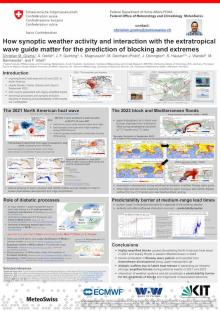How synoptic weather activity and interaction with the extratropical wave guide matter for the prediction of blocking and associated extremes
Christian M.
Grams
Federal Institute of Meteorology and Climatology, MeteoSwiss, Zurich-Airport, Switzerland
Poster
Blocking anticyclones embedded in highly amplified Rossby waves and flanked by station-ary cut-off cyclones can cause devastating extreme events. However, often the magnitude of such extremes is difficult to predict on medium- to subseasonal lead times. In this presenta-tion we discuss the synoptic evolution of two recent extreme events: The heat wave in west-ern North America in June 2021 and the extreme rainfall in the Eastern Mediterranean in September 2023. For both cases we show that the downstream development triggered by the interaction of synoptic weather systems with the upper-tropospheric wave guide in regions far upstream ultimately lead to highly amplified Rossby Waves. Thereby, the interaction of diabatic outflow due to latent heat release in ascending air streams with the jet is key and the exact phasing and timing of this interaction represents a predictability barrier with regard to the magnitude of downstream ridge and associated extreme events. Therefore, probabilistic weather forecasts are only able to predict the extremity of the events once the complex inter-action of synoptic activity is captured. Thus, the sequence of individual weather events limits the predictability of the magnitude of extremes linked to highly amplified Rossby waves. We conclude that a correct assessment of highly amplified Rossby waves for weather prediction and climate projection requires large ensembles in order to capture the rare sequence of in-teractions causing such extremes. Also, an accurate representation of the physical and dy-namical processes across spatiotemporal scales in particular of moist processes on synoptic weather scales would help, however, there are indications that the predictability barrier is intrinsic in nature.

Poster file
Grams_Christian_blocking_poster.pdf
(3.53 MB)
Meeting homepage
